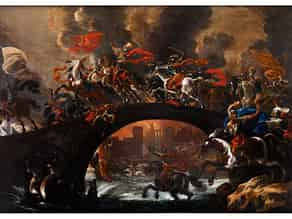Ricerca Vincent Adriaenssen nell’asta
Dipinti XVI - XVIII secolo
mercoledì, 1 luglio 2015
» rimettere
Il Vostro Art Agent personale

Siete interessati alle opere di Vincent Adriaenssen?
Volentieri Vi teniamo aggiornati, quando le opere di Vincent Adriaenssen verranno offerte in una delle nostre prossime aste.
Vi preghiamo di accettare la nostra politica sulla privacy
705
Vincent Adriaenssen, gen. „Il Manciola“
oder „Il Mozzo di Anversa“,
1595 Antwerpen - 1675 Rom
SCHLACHTENGEMÄLDE MIT PFERDEN AUF EINER BRÜCKE Öl auf Leinwand.
121 x 170 cm.
Gerahmt.
Prezzo del catalogo € 12.000 - 15.000
Prezzo del catalogo€ 12.000 - 15.000
$ 12,960 - 16,200
£ 10,800 - 13,500
元 93,840 - 117,300
₽ 1,193,880 - 1,492,350
Vincent Adriaenssen lernte sein Handwerk in Flandern im Kreis um Rubens; später zog er nach Rom, wo er bis zu seinem Lebensende blieb und ein sehr produktiver und anerkannter Schlachtenmaler wurde. Dieses Genre war, um die Mitte des Jahrhunderts, in der ewigen Stadt sehr beliebt. Sein malerischer Ausdruck bewegt sich zwischen dem späten Cavalier d'Arpino und Tempesta, besitzt jedoch auch Anklänge an Rubens und die barocken Innovationen eines Jacques Courtois „l Borgognone“. Die lebhafte Darstellung dieser Schlacht auf der Brücke besitzt jene künstlerische, stilistische Reife, die Giancarlo Sestieri dazu bewegte, dieses Gemälde als „eines (von Adriaenssens) besten Werken überhaupt...“ zu bezeichnen. „Il Manciola bringt hier gelungen seine extrovertierte Lebhaftigkeit zum Ausdruck und stellt seine reife Meisterschaft unter Beweis“ (2004, S. 223). Weiter merkt Sestieri (2011, S. 22)an: Die Pferde und Reiter, die auf dem Gemälde in großer Zahl zu sehen sind, besäßen „Dynamik und eine ausgefallene Gestik ... als seien sie künstlich in ihrer Bewegung zum Erstarren gebracht worden“.
Literatur:
Giancarlo Sestieri, Antico e moderno nella pittura di „battaglia“. Contibuti al Manciola, a Michelangelo delle Battaglie e al Borgogonone, in: Studi sul Barocco romano. Scritti in onore dei Maurizio Fagiolo dell'Arco, Mailand, 2004, S. 219-229.
Ausstellungskatalog Rom, Giancarlo Sestieri (Hrsg.), I Battaglisti. La pittura di battaglia dal XVI al XVIII secolo, Rom, 2011, Nr. 2, S. 22-23.
Ausstellungen:
I Battaglisti. La pittura di battaglia dal XVI al XVIII secolo, Tivoli Villa d'Este, 16. Juni - 30. Oktober 2011. (10124012) (21)
Vincent Adriaenssen, also known as “il Manciola” or “il Mozzo di Anversa”,
1595 Antwerp - 1675 Rome
BATTLE SCENE WITH HORSES ON A BRIDGE
Vincent Adriaenssen learned his craftsmanship in Flanders in the circle surrounding Rubens. He later moved to Rome where he remained until the end of his life and became a very prolific and renowned painter of battle scenes. This genre was very popular in the eternal city in the middle of the century. His painterly expression ranges between the late Cavalier d’Arpino and Tempesta, but is also reminiscent of Rubens and the Baroque innovations of Jaques Courtois “il Borgognone”. The lively depiction of the battle on the bridge displays the artistic, stylistic maturity which led Giancarlo Sestieri to describe this painting as “one (of Adriaenssen’s) best works ever. Here ‘Il Manciola’ succeeds in expressing his extrovert vivacity and demonstrates his mature mastery” (2004, p. 223). Furthermore Sestieri notes that (2011, p. 22) the horses and riders, which can be seen in great numbers on the painting are “dynamic and show exceptional gestures (...) as if they have been artificially frozen in their movement”.
Literature:
Giancarlo Sestieri, Antico e moderno nella pittura di “battaglia”. Contibuti al Manciola, a Michelangelo delle Battaglie e al Borgogonone, in: “Studi sul Barocco romano. Scritti in onore dei Maurizio Fagiolo dell’Arco”, Milan, 2004, pp. 219-229.
Exhibition catalogue Rome, Giancarlo Sestieri (ed.), I Battaglisti. La pittura di battaglia dal XVI al XVIII secolo, Rome, 2011, no. 2, pp. 22-23.
Exhibitions:
I Battaglisti. La pittura di battaglia dal XVI al XVIII secolo, Tivoli Villa d’Este, 16 June - 30 October 2011.
This object has been individually compared to the information in the Art Loss Register data bank and is not registered there as stolen or missing.
Il Vostro Art Agent personale
Volete essere informati quando nelle nostre prossime aste un’opera di Vincent Adriaenssen viene offerta? Attivate qui il Vostro Art Agent personale.
Vi preghiamo di accettare la nostra politica sulla privacy
Volete comprare un′opera di Vincent Adriaenssen?
Il Vostro Art Agent Comprare in Private Sale Date delle aste
I nostri esperti sono felici di assistervi personalmente nella Vostra ricerca di opere d′arte
Volete vendere un′opera di Vincent Adriaenssen?
Consegnate ora Vendita privata FAQ
Le vostre consegne sono sempre benvenute. Il nostro team sarà felice di assistervi personalmente in ogni fase trattative. Aspettiamo le vostre chiamate.
Contattate i nostri esperti




















